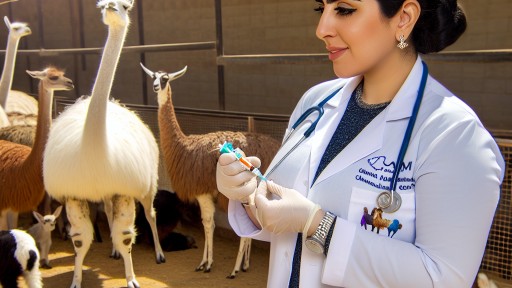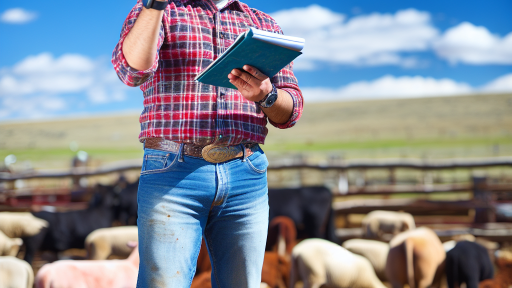Importance of Adequate Space for Livestock Comfort
Providing adequate space is essential for livestock comfort.
Comfortable living conditions enhance animal well-being.
Livestock that feel safe and relaxed perform better.
Crowded environments can lead to stress and health issues.
Stress negatively impacts growth rates and productivity.
Physical Health and Movement
Space allows animals to move freely and engage in natural behaviors.
Animals need room for social interactions among their herd.
Adequate space reduces the risk of injuries during movement.
Healthy movement patterns support physical fitness.
Fitness is crucial for overall health and productivity.
Environmental Control
Appropriate spacing improves air circulation and ventilation.
Poor ventilation can lead to harmful respiratory issues.
Good airflow helps maintain a comfortable temperature.
Temperature control is vital during extreme weather conditions.
Livestock need environments that minimize temperature stress.
Transform Your Agribusiness
Unlock your farm's potential with expert advice tailored to your needs. Get actionable steps that drive real results.
Get StartedBehavioral Aspects
Proper spacing allows for better behavioral expression.
Animals can exhibit their natural instincts without restriction.
Social structures develop naturally in spacious environments.
This promotes a healthier and more balanced herd dynamic.
Moreover, behavioral enrichment leads to happier livestock.
Impact on Reproductive Success
Space allocation can influence reproductive performance.
Crowding often leads to reproductive stress and complications.
Healthy mating behaviors occur in less crowded settings.
Research shows that adequate space improves breeding outcomes.
Ultimately, this contributes to sustainable livestock production.
Ventilation Systems: Ensuring Air Quality and Temperature Control
Importance of Adequate Ventilation
Adequate ventilation is crucial in livestock housing.
It ensures fresh air circulation throughout the facility.
Moreover, it helps maintain optimal temperature levels.
Proper ventilation reduces humidity and prevents moisture buildup.
This practice minimizes the risk of respiratory diseases among animals.
Components of Effective Ventilation Systems
Modern ventilation systems consist of various components.
These include fans, ducts, and filters for air quality enhancement.
Additionally, they may feature automated controls for efficiency.
Fan Selection
Selecting the right fans is paramount for effective airflow.
Exhaust fans remove stale air, while intake fans introduce fresh air.
When properly sized and positioned, they significantly affect air quality.
Duct Design
Well-designed ducts distribute air evenly throughout the barn.
They should minimize dead zones where air stagnates.
Optimizing duct design ensures all areas receive sufficient airflow.
Showcase Your Farming Business
Publish your professional farming services profile on our blog for a one-time fee of $200 and reach a dedicated audience of farmers and agribusiness owners.
Publish Your ProfileNatrual vs. Mechanical Ventilation
There are primarily two types of ventilation systems.
Natural ventilation relies on wind and temperature differences.
In contrast, mechanical ventilation uses fans for controlled airflow.
Each system has its advantages and considerations.
Natural Ventilation
This method is cost-effective and energy-efficient.
However, its effectiveness can depend on weather conditions.
Proper building design maximizes natural air movement.
Mechanical Ventilation
Mechanical systems provide consistent air quality control.
They are particularly useful in extreme weather situations.
Additionally, they facilitate monitoring of indoor air parameters.
Monitoring Air Quality
Regular monitoring of indoor air quality is essential.
Parameters such as ammonia levels, humidity, and temperature should be checked.
These assessments help in maintaining a healthy environment.
Utilizing sensors can automate this process for better efficiency.
Benefits of Proper Ventilation
Effective ventilation enhances animal welfare significantly.
It contributes to improved growth rates and reproductive performance.
Furthermore, it reduces feed conversion ratios, boosting profitability.
Investing in ventilation systems pays off in the long run.
Insulation and Climate Control: Keeping Livestock Healthy Year-Round
The Importance of Proper Insulation
Proper insulation plays a vital role in livestock housing.
It helps maintain a stable temperature across all seasons.
As a result, animals remain comfortable and productive.
Well-insulated structures reduce energy consumption.
This minimizes heating and cooling costs for farmers.
Climate Control Systems
Advanced climate control systems provide optimal living conditions.
These systems include ventilation, heating, and cooling tools.
They help manage humidity levels within the housing environment.
Maintaining appropriate humidity protects livestock from diseases.
Effective ventilation is essential for air quality and odor control.
Benefits of Year-Round Climate Control
Consistent climate control improves animal welfare significantly.
Healthy livestock produce more milk and meat.
Farmers experience lower veterinary costs as well.
Overall, climate control enhances profitability for agricultural operations.
Best Practices for Insulation and Climate Control
Choose high-quality insulation materials for livestock housing.
Consider using reflective materials to manage heat gain.
Regular maintenance of heating and cooling systems is crucial.
Lastly, involve professionals for the best results in installation.
See Related Content: Optimal Feeding Practices for Goats
Sustainable Materials and Construction Practices in Livestock Housing
Importance of Sustainable Materials
Sustainable materials enhance environmental conservation in livestock housing.
These materials reduce waste and promote recycling efforts.
Consequently, they help decrease the overall carbon footprint of farming operations.
Showcase Your Farming Business
Publish your professional farming services profile on our blog for a one-time fee of $200 and reach a dedicated audience of farmers and agribusiness owners.
Publish Your ProfileExamples of Sustainable Materials
Wood from sustainably managed forests is a practical choice.
Recycled steel offers durability and minimizes raw material use.
Additionally, hempcrete provides insulation and is biodegradable.
Using concrete made with recycled aggregates also supports eco-friendly practices.
Construction Practices to Consider
Choosing local materials can significantly cut transportation emissions.
Moreover, implementing energy-efficient designs reduces overall energy consumption.
Passive solar heating techniques help maintain comfortable temperatures naturally.
Installing rainwater harvesting systems ensures efficient water use.
Benefits of Sustainable Construction
Sustainable construction methods lead to lower operating costs in the long run.
They create healthier living conditions for livestock and workers alike.
Additionally, these practices improve community relationships through responsible farming.
Adopting these features promotes resilience in agricultural systems.
Gain More Insights: Maintaining Transport Vehicles for Livestock Safety
Access to Clean Water and Feeding Areas: Promoting Animal Welfare
Importance of Clean Water Access
Access to clean water is crucial for livestock health.
Animals require adequate hydration for optimal growth.
In addition, clean water promotes better feed digestion.
Farmers must ensure water sources are regularly monitored.
Preventing contamination minimizes health risks for animals.
Feeding Areas: Design and Location
Proper feeding areas play a significant role in animal welfare.
These areas should be spacious to allow free movement.
Furthermore, easy access to feeding sites encourages consumption.
Farmers should prioritize cleanliness in feeding zones.
This practice helps in preventing foodborne diseases.
Integration of Water and Feeding Systems
Integrating water and feeding systems enhances efficiency.
Animals benefit from reduced travel time between resources.
This integration also simplifies management for farmers.
Moreover, it encourages consistent feeding and drinking patterns.
Monitoring and Maintenance
Regular monitoring of water quality is essential.
Farmers should conduct routine checks for contaminants.
Maintaining feeding equipment also requires attention.
Scheduled cleaning prevents build-up of harmful bacteria.
Overall, maintenance ensures a sustainable environment for livestock.
Uncover the Details: Building Secure Facilities for Exotic Animals

Waste Management Solutions
Importance of Waste Management
Effective waste management is crucial for livestock housing.
It ensures the health and productivity of the animals.
Moreover, it minimizes environmental pollution.
Proper practices can improve overall farm efficiency.
Farmers face numerous challenges in managing waste.
Implementing effective strategies can make a significant difference.
Types of Waste Treatment Systems
Diverse waste treatment systems are available for farms.
Showcase Your Farming Business
Publish your professional farming services profile on our blog for a one-time fee of $200 and reach a dedicated audience of farmers and agribusiness owners.
Publish Your ProfileEach system has unique benefits and challenges.
Consider the following systems for waste management:
- Composting systems
- Anaerobic digestion
- Manure storage lagoons
- Biofilters
Composting Systems
Composting converts organic waste into valuable fertilizer.
This method promotes beneficial microbial activity.
Furthermore, it reduces odors and pathogens.
Farmers can use compost in crop production.
Additionally, it enhances soil structure and fertility.
Anaerobic Digestion
Anaerobic digestion processes organic waste without oxygen.
This method produces biogas, a renewable energy source.
Farmers can use biogas for heating or electricity.
Moreover, the byproduct is nutrient-rich digestate.
This digestate can also be applied to fields.
Manure Storage Lagoons
Manure storage lagoons hold large volumes of waste.
They provide necessary space for managing manure efficiently.
Regular monitoring ensures compliance with regulations.
Effective cover systems reduce evaporation and odors.
Biofilters
Biofilters treat air and odors from livestock buildings.
They utilize natural processes to filter emissions.
These systems can significantly enhance air quality.
Farmers can achieve better acceptance from nearby communities.
Best Practices for Waste Management
Implementing best practices enhances waste management efficiency.
Farmers should always follow relevant regulations.
Regular training for staff is beneficial.
Maintain detailed records for compliance and improvement.
Lastly, consider integrating multiple strategies for optimal results.
Discover More: Waste Management In Livestock Facilities
Safety Features: Protecting Livestock from Predators and Harsh Weather
Strong fencing keeps livestock secure from predators.
Types of fencing include electric, barbed wire, and stock fencing.
Calculate the height and depth needed for effective barriers.
Regular inspections ensure fences remain intact and effective.
Secure Shelters
Livestock housing should provide protection from extreme weather.
Design shelters to resist strong winds and heavy snowfall.
Proper ventilation helps regulate temperature and air quality.
Insulated walls maintain warmth during cold months.
Safety Features in Design
Integrate safety features into the overall design of housing.
Use non-toxic materials to prevent health risks.
Avoid sharp edges or protrusions that could injure animals.
Design access points for easy monitoring and management.
Predator Deterrents
Implement motion-activated lights to scare off predators.
Use guard animals to protect livestock from threats.
Showcase Your Farming Business
Publish your professional farming services profile on our blog for a one-time fee of $200 and reach a dedicated audience of farmers and agribusiness owners.
Publish Your ProfileDeploy security cameras to monitor the premises.
Regularly educate staff on recognizing predator signs.
Emergency Preparedness
Establish emergency plans for swift action.
Regular drills ensure everyone knows their roles.
Maintain first aid supplies specifically for livestock.
Stay informed on local wildlife activity for alerts.
Technology Integration: Smart Farming Solutions in Livestock Management
Introduction to Smart Farming
Smart farming revolutionizes livestock management through technology integration.
This modern approach enhances productivity, efficiency, and animal welfare.
Furthermore, it allows farmers to make informed decisions based on data.
Utilizing IoT for Monitoring
The Internet of Things (IoT) plays a vital role in livestock management.
IoT devices monitor animal health, location, and environmental conditions.
For example, wearables track vital signs and movements of livestock.
As a result, farmers receive real-time alerts on any anomalies.
Data Analytics for Better Decisions
Data analytics offers insights for improving livestock productivity.
By analyzing historical data, farmers can identify patterns and trends.
For instance, they can optimize feeding schedules to reduce waste.
Moreover, predictive analytics helps anticipate health issues before they escalate.
Automated Feeding Systems
Automated feeding systems save time and improve feed accuracy.
These systems ensure livestock receive the right amount of nutrients consistently.
Consequently, this leads to faster growth rates and reduced feed costs.
Additionally, automation minimizes human error in feeding operations.
Enhanced Biosecurity Measures
Technology enhances biosecurity in livestock housing systems.
Cameras and sensors monitor biosecurity breaches, alerting farmers promptly.
Automation in cleaning routines reduces the risk of disease spread.
Consequently, improved biosecurity ensures the health of the herd.
Remote Management Capabilities
Remote management allows farmers to control operations from anywhere.
Smart farming applications provide connectivity to various devices.
Farmers can monitor livestock status and environments using mobile devices.
This flexibility enables quick responses to emerging situations.
Future Trends in Smart Farming
The future of smart farming includes advancements like AI and machine learning.
These technologies will further refine livestock management practices.
As a result, farmers will achieve increased automation and efficiency.
Ultimately, this transformation supports sustainable agricultural practices.
Additional Resources
ANSC – Animal Science | University of Maryland Catalog
Intensive poultry farming: A review of the impact on the environment …




